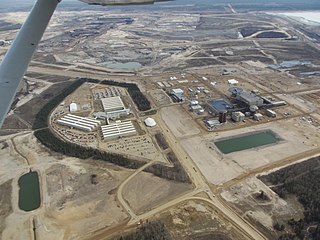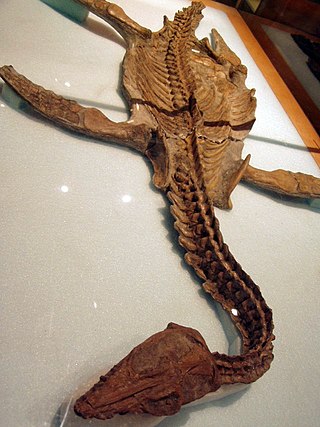
The order Pinales in the division Pinophyta, class Pinopsida, comprises all the extant conifers. The distinguishing characteristic is the reproductive structure known as a cone produced by all Pinales. All of the extant conifers, such as Araucaria, cedar, celery-pine, cypress, fir, juniper, kauri, larch, pine, redwood, spruce, and yew, are included here. Some fossil conifers, however, belong to other distinct orders within the division Pinophyta.

Ephedraceae is a family of gymnosperms belonging to Gnetophyta, it contains only a single extant genus, Ephedra, as well as a number of extinct genera from the Early Cretaceous.

Araucariaceae – also known as araucarians – is a family of coniferous trees, with three living genera, Araucaria, Agathis, and Wollemia. While the family was distributed globally during the Jurassic and Cretaceous periods, in their native distribution they are now largely confined to the Southern Hemisphere, except for a few species of Agathis in Southeast Asia.

Gnetophyta is a division of plants, grouped within the gymnosperms, that consists of some 70 species across the three relict genera: Gnetum, Welwitschia, and Ephedra. The earliest unambiguous records of the group date to the Jurassic, and they achieved their highest diversity during the Early Cretaceous. The primary difference between gnetophytes and other gymnosperms is the presence of vessel elements, a system of small tubes (xylem) that transport water within the plant, similar to those found in flowering plants. Because of this, gnetophytes were once thought to be the closest gymnosperm relatives to flowering plants, but more recent molecular studies have brought this hypothesis into question, with many recent phylogenies finding them to be nested within the conifers.

The gymnosperms are a group of seed-producing plants that includes conifers, cycads, Ginkgo, and gnetophytes, forming the clade Gymnospermae. The term gymnosperm comes from the composite word in Greek: γυμνόσπερμος, literally meaning 'naked seeds'. The name is based on the unenclosed condition of their seeds. The non-encased condition of their seeds contrasts with the seeds and ovules of flowering plants (angiosperms), which are enclosed within an ovary. Gymnosperm seeds develop either on the surface of scales or leaves, which are often modified to form cones, or on their own as in yew, Torreya, Ginkgo. Gymnosperm lifecycles involve alternation of generations. They have a dominant diploid sporophyte phase and a reduced haploid gametophyte phase which is dependent on the sporophytic phase. The term "gymnosperm" is often used in paleobotany to refer to all non-angiosperm seed plants. In that case, to specify the modern monophyletic group of gymnosperms, the term Acrogymnospermae is sometimes used.

The family Oedemeridae is a cosmopolitan group of beetles commonly known as false blister beetles, though some recent authors have coined the name pollen-feeding beetles. There are some 100 genera and 1,500 species in the family, mostly associated with rotting wood as larvae, though adults are quite common on flowers. The family was erected by Pierre André Latreille in 1810.

Albian Sands Energy Inc. is the operator of the Muskeg River Mine and Jack Pine Mine, an oil sands mining project located 75 kilometres (47 mi) north of Fort McMurray, Alberta, Canada. It is a joint venture between Shell Canada (10%), CNRL (70%) and Chevron Canada (20%). The company's legal headquarters are located in the Shell Centre in Calgary, Alberta. Albian Sands got its name from the Albian Boreal Sea which, during the Albian stage of the Cretaceous, moved over the McMurray sands and deposited a blanket of marine shale on its floor which trapped the hydrocarbons of the McMurray Formation. The oil sands resources of the Muskeg River Mine are a legacy of the Albian Sea.

Nichollssaura is an extinct genus of leptocleidid plesiosaur from the Early Cretaceous Boreal Sea of North America. The type species is N. borealis, found in the early Albian age Clearwater Formation near Fort McMurray, Alberta, Canada.

Ophthalmosauridae is an extinct family of thunnosaur ichthyosaurs from the Middle Jurassic to the early Late Cretaceous worldwide. Almost all ichthyosaurs from the Middle Jurassic onwards belong to the family, until the extinction of ichthyosaurs in the early Late Cretaceous. Opthalmosaurids appeared worldwide during early Bajocian, subsequent to the disappearance of most other ichthyosaur lineages after the end of the Toarcian. Currently, the oldest known ophthalmosaurids is Mollesaurus from the early Bajocian of Argentina, as well as indeterminate remains of the same age from Luxembourg and Canada. Named by George H. Baur, in 1887, the family contains the basal taxa like Ophthalmosaurus. Appleby (1956) named the taxon Ophthalmosauria which was followed by some authors, but these two names are often treated as synonyms; Ophthalmosauridae has the priority over Ophthalmosauria. However, some researchers argue that Ophthalmosauridae should be restricted to the group typically referred to as Ophthalmosaurinae, with classic Platypterygiinae instead being referred to as Undorosauridae or Brachypterygiidae and Ophthalmosauria being used to unite these two groups.
Mollesaurus is an extinct genus of large ophthalmosaurine ophthalmosaurid ichthyosaur known from northwestern Patagonia of Argentina.
The Khuren Dukh Formation, also known as the Khukhtyk Formation, Khukhteeg Formation, or Hühteeg Svita,, is a geological formation in Mongolia whose strata date back to the Aptian–Albian ages of the Early Cretaceous. Dinosaur remains are among the fossils that have been recovered from the formation.

Wintonotitan is a genus of titanosauriform dinosaur from Cenomanian -age Winton Formation of Australia. It is known from partial postcranial remains.

A seed plant or spermatophyte, also known as a phanerogam or a phaenogam, is any plant that produces seeds. It is a category of embryophyte that includes most of the familiar land plants, including the flowering plants and the gymnosperms, but not ferns, mosses, or algae.
Paleontology or palaeontology is the study of prehistoric life forms on Earth through the examination of plant and animal fossils. This includes the study of body fossils, tracks (ichnites), burrows, cast-off parts, fossilised feces (coprolites), palynomorphs and chemical residues. Because humans have encountered fossils for millennia, paleontology has a long history both before and after becoming formalized as a science. This article records significant discoveries and events related to paleontology that occurred or were published in the year 2011.
The Tlayúa Formation is an Early Cretaceous geological formation near Tepexi de Rodríguez, Puebla.
The Sannine Formation, also called the Sannine Limestone, is a Cretaceous geologic formation in Lebanon.

Zhangsolvidae is an extinct family of brachyceran flies known from the Cretaceous period. Members of the family possess a long proboscis, varying in length between 1.3 and 7 mm depending on the species, and were probably nectarivores. A specimen has been found with preserved Bennettitales pollen, suggesting that they acted as pollinators for extinct gymnosperms. They are considered to be members of the Stratiomyomorpha.
Pentoxylales is an extinct order of seed plants known from the Jurassic and Early Cretaceous of East Gondwana.
Dinophyton is an extinct genus of gymnosperm found in late Triassic beds in North America. Its taxonomy is debated, but it may be a gnetophyte with bisaccate pollen.

Umaltolepis is an extinct genus of seed plant, known from the Early Jurassic to Early Cretaceous of Asia. Within the form classification system used within paleobotany, it refers to the seed-bearing reproductive structures, which grew on woody plants with strap-shaped Ginkgo-like leaves assigned to the genus Pseudotorellia.












